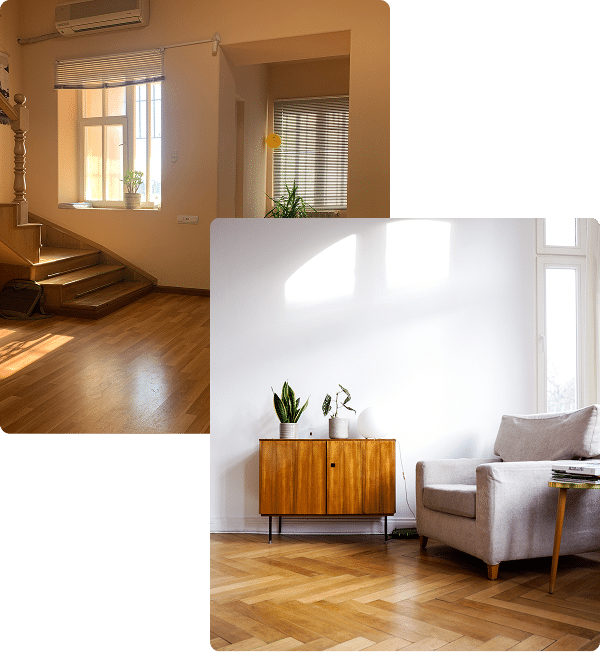Understanding Your Hardwood Flooring Options
When planning a hardwood flooring project, one of the most fundamental decisions you'll face is choosing between solid and engineered hardwood. Both are genuine hardwood products that add beauty and value to your home, but they differ significantly in their construction, performance, and ideal applications.
At Dean's Floor Service, with over 35 years of experience installing and refinishing hardwood floors, we've worked extensively with both solid and engineered products. This comprehensive guide will help you understand the key differences, enabling you to make an informed decision for your specific needs.
What's the Difference? Understanding Construction
Solid Hardwood
Solid hardwood is exactly what it sounds like—solid wood from top to bottom, typically 3/4" thick. Each plank is milled from a single piece of hardwood timber.
Construction Details:
- Milled from a single piece of timber
- Typically 3/4" thick
- Traditional tongue-and-groove design
- Available in various widths (typically 2 1/4" to 5")
- Can be site-finished or pre-finished
Engineered hardwood
Engineered hardwood consists of a real hardwood veneer (wear layer) bonded to a plywood or high-density fiberboard (HDF) core. This construction creates a product with enhanced stability.
Construction Details:
- Real hardwood veneer top layer (wear layer)
- Multiple cross-layered plywood or HDF core
- Varying total thickness (typically 3/8" to 3/4")
- Wear layer thickness ranges from 1/16" to 1/4"
- Available in wider planks than solid hardwood
- Commonly pre-finished but also available unfinished
Performance Comparison: How They Behave in Your Home
One of the most significant differences between solid and engineered hardwood is how they respond to environmental changes.
Solid Hardwood:
- Naturally expands and contracts with humidity changes
- May develop gaps between boards during dry winter months
- May experience cupping or crowning with excessive moisture
- Requires acclimation before installation
Engineered Hardwood:
- Multi-ply construction limits expansion and contraction
- More resistant to seasonal movement
- Better performance in varying humidity conditions
- Still requires acclimation, but less susceptible to environmental changes
Installation Considerations
The installation options differ between these two types of hardwood flooring.
Solid Hardwood:
- Typically nail-down installation
- Requires proper subfloor (plywood or OSB)
- Not suitable for direct concrete installation
- Professional installation recommended
Engineered Hardwood:
- Multiple installation methods:
- Floating (click-lock or glue between boards)
- Glue-down (directly to subfloor)
- Nail-down (similar to solid)
- Can be installed over various subfloors including concrete
- Some products suitable for DIY installation
Aesthetic Considerations
Both types offer beautiful, authentic hardwood aesthetics with some subtle differences.
Solid Hardwood:
- Traditional, seamless appearance when site-finished
- No bevels between boards when site-finished
- Limited to standard plank widths (typically up to 5")
- Available in virtually all domestic species
Engineered Hardwood:
- Available in wider plank formats (up to 7" or more)
- Pre-finished options often have micro-beveled edges
- Some exotic species only available in engineered format
- Visual appearance indistinguishable from solid once installed
Cost Considerations
The price difference between solid and engineered hardwood varies based on quality, species, and other factors.
Solid Hardwood:
- Mid-range price point for domestic species
- Premium price for exotic species
- Additional cost for site finishing if purchased unfinished
- Installation typically requires professional expertise
Engineered Hardwood:
- Wide price range based on quality and wear layer thickness
- Entry-level products less expensive than solid hardwood
- Premium engineered products often more expensive than solid
- Some suitable for DIY installation, potentially reducing total project cost
Ideal Applications: Where Each Type Shines
Solid hardwood performs best in:
- Main and upper floors
- Bedrooms, living rooms, dining rooms
- Environments with stable humidity
- Homes with proper HVAC and humidity control
- Applications where long-term refinishing is desired
Making Your Decision: What to Consider
- Does your area experience extreme seasonal humidity changes?
- Do you have reliable climate control in your home?
- Is there a functioning humidifier on your furnace?
Whether you are looking to restore an existing floor or install a new hardwood floor, we'll give you an honest, straight forward estimate.

The Dean's Floor Service Approach
At Dean's Floor Service, we install and refinish both solid and engineered hardwood floors. Our recommendations are always based on what's best for your specific situation, not on sales tactics or profit margins.
We'll help you weigh all the factors—including location, subfloor, plank width, humidity control, budget, and aesthetic preferences—to determine which option will perform best in your home and meet your expectations.
Our expertise with both products allows us to provide honest, practical advice. Sometimes the answer is clearly one or the other; other times, both products would perform well, and the choice comes down to your personal preferences.
Request Your Free Consultation Today or call us at 708-424-3011 to discuss which hardwood flooring option is right for your home.
Quality you can stand on since 1988

